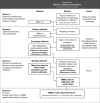Assessing the analytical performance of systems for self-monitoring of blood glucose: concepts of performance evaluation and definition of metrological key terms
- PMID: 24351185
- PMCID: PMC3876337
- DOI: 10.1177/193229681300700619
Assessing the analytical performance of systems for self-monitoring of blood glucose: concepts of performance evaluation and definition of metrological key terms
Abstract
Reliability of blood glucose (BG) measurements is a prerequisite for successful diabetes management. Publications on the evaluation of self-monitored glucose values, however, are frequently characterized by a confusion in terminology. We provide an inventory of key terms such as accuracy, trueness, precision, traceability, calibration, and matrix effect to avoid future misunderstanding. Definitions are taken from the metrological literature and international norms and explained in a language intended for nonspecialists in metrology. The terms are presented in light of the need to apply generally accepted definitions. In addition, a description of requirements and components for a sound evaluation of BG measurement systems is presented. These factors will also enable improvement in future comparisons of study results.
© 2013 Diabetes Technology Society.
Figures





References
-
- Abraira C, Colwell JA, Nuttall FQ, Sawin CT, Nagel NJ, Comstock JP, Emanuele NV, Levin SR, Henderson W, Lee HS. Veterans Affairs Cooperative Study on glycemic control and complications in type II diabetes (VA CSDM). Results of the feasibility trial. Veterans Affairs Cooperative Study in Type II Diabetes. Diabetes Care. 1995;18(8):1113–1123. - PubMed
-
- Durán A, Martín P, Runkle I, Pérez N, Abad R, Fernández M, Del Valle L, Sanz MF, Calle-Pascual AL. Benefits of self-monitoring blood glucose in the management of new-onset type 2 diabetes mellitus: the St Carlos Study, a prospective randomized clinic-based interventional study with parallel groups. J Diabetes. 2010;2(3):203–211. - PubMed
-
- Fisher L, Polonsky WH, Parkin CG, Jelsovsky Z, Petersen B, Wagner RS. The impact of structured blood glucose testing on attitudes toward self-management among poorly controlled, insulin-naive patients with type 2 diabetes. Diabetes Res Clin Pract. 2012;96(2):149–155. - PubMed
-
- Franciosi M, Lucisano G, Pellegrini F, Cantarello A, Consoli A, Cucco L, Ghidelli R, Sartore G, Sciangula L. Nicolucci A; ROSES Study Group. ROSES: role of self-monitoring of blood glucose and intensive education in patients with Type 2 diabetes not receiving insulin. A pilot randomized clinical trial. Diabet Med. 2011;28(7):789–796. - PubMed
-
- International Diabetes Federation. IDF guideline on self-monitoring of blood glucose in non-insulin treated type 2 diabetes. http://www.idf.org/guidelines/self-monitoring.
Publication types
MeSH terms
Substances
LinkOut - more resources
Full Text Sources
Other Literature Sources
Medical

